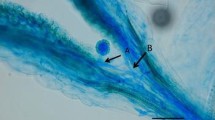Summary
1. Self-incompatibility in diploid pears is due to arrested pollen-tube growth. Three days after pollination the tubes are approximately one-third of the way down the style and their ends are swollen.
2. In a cross between two diploid varieties compatible and incompatible tubes are present indicating gametic determination of incompatibility.
3. The somatically doubled autotetraploid Fertility is self-fertile, but both compatible and incompatible tubes are present in selfed styles. Compatible tubes of the tetraploid grow faster than compatible tubes of diploids both in tetraploid and in diploid styles.
4. The breakdown of the self-sterility mechanism following chromosome doubling is reviewed and found to be of fairly widespread occurrence in plants. A working hypothesis to explain the effect of polyploidy on self-sterility is given: it is based on the assumption thatS 1 S 2 pollen is compatible andS 1 S 1 andS 2 S 2 pollen incompatible inS 1 S 1 S 2 S 2 styles.
5. Pollen tubes of the diploid variety Beurré Bedford grow as fast as those of a tetraploid variety, penetrate the style and enter the embryosac; but only rarely do they effect fertilization. Beurré Bedford pollen grains are unreduced pollen mother cells with haploid, diploid, triploid, and tetraploid nuclei. The high rate of growth of the pollen tubes is due to the nature of the pollen cell and the failure to fertilize the eggs to the lack of balance between the sperm nuclens and the cell.
6. The result of this normal pollen-tube growth without fertilization is the formation of seedless fruits.
Similar content being viewed by others
References
Anderson, E. &Sax, K. (1934). A cytological analysis of self-sterility inTradescantia.Bot. Gaz.43, 609–21.
Asami, Y. &Hayami, F. (1934). The growth of pollen tubes in incompatible pollinations of Japanese pears.J. horst. Ass. Jap.5, 222–32.
Blakeslee, A. F. (1938). Chromosome investigations.Rep. Dep. Genet. Carn. Inst. Wash. for 1937–8, pp. 35–40.
Blakeslee, A. F. &Avery, A. G. (1937). Methods of inducing chromosome doubling in plants by treatment with colchicine.Science,86, 408.
Crane, M. B. (1923). Report on tests of self-sterility and cross-incompatibility in plums, cherries, and apples at the John Innes Horticultural Institution.J. Pom. Hort. Sci.3, 5–18.
Crane, M. B. &Lewis, D. (1941). Genetical studies in pears. III. Incompatibility and sterility.J. Genet.43, 31–44.
Crane, M. B. &Thomas, P. T. (1939). Genetical studies in pears. I. The origin and behaviour of a new giant form.J. Genet.37, 287–99.
Cummings, M. B.,Jenkins, E. W. &Dunning, R. G. (1936). Sterility in pears.Bull. Verm. agric. Exp. Sta. no. 408, pp. 1–84.
Darlington, C. D. (1939).Evolution of Genetic Systems. Cambridge.
East, E. M. (1934). Norms of pollen-tube growth in incompatible matings of self-sterile plants.Proc. nat. Acad. Sci., Wash.,20, 225–30.
Emerson, S. (1938). The genetics of self-incompatibility inOenothera organensis.Genetics,23, 190–202.
Emerson, S. (1940).
Heilborn, D. (1938). Pollen-tube growth in self-pollinated flowers of diploid apple varieties.Ann. Agric. Coll. Sweden,5, 165–77.
Lawrence, W. J. C. (1930). Incompatibility in polyploids.Genetica,12, 268–94.
Levan, A. (1936). Polyploidy and self-sterility inAllium.Hereditas, Lund,22, 278–80.
Raptopoulos, T. (1941). Pollen tube growth studies in cherries.J. Genet.42, 73–90.
Sears, E. R. (1937). Cytological phenomena concerned with self-sterility in the flowering plants.Genetics,22, 130–81.
Shamel, A. D. (1937). A large-fruited bud mutation of the Winter Nelis pear.J. Hered.28, 350–2.
Upcott, M. B. &Philp, J. (1939). The genetic structure ofTulipa. IV. Balance, selection and fertility.J. Genet.38, 91–123.
Weeks, W. &Latimer, L. P. (1938). Incompatibility of Early McIntosh and Cortland apples.Proc. Amer. Soc. Hort. Sci.36, 284–6.
Yasuda, S. (1934). Physiological research on self-incompatibility inPetunia violacea.Bull. imp. Coll. Agric. Morioka,20, 1–95.
—— (1939). Parthenocarpy induced by stimulation of pollination in some higher plants.Mem. Fac. Sci. Agric. Taikoku Univ. 27, 1–51.
Author information
Authors and Affiliations
Rights and permissions
About this article
Cite this article
Lewis, D., Modlibowska, I. Genetical studies in pears. Journ. of Genetics 43, 211–222 (1942). https://doi.org/10.1007/BF02982754
Issue Date:
DOI: https://doi.org/10.1007/BF02982754




